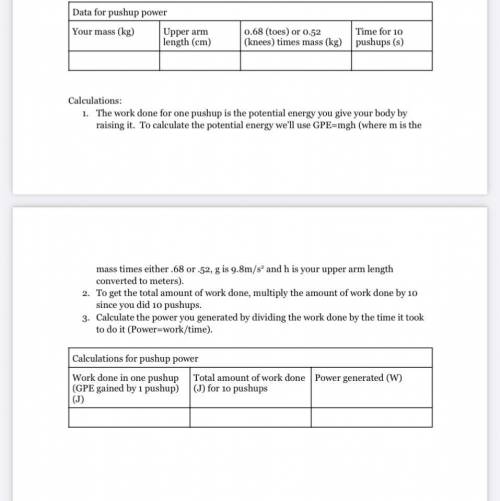Background information:
We know that power is the rate that work is done; what that
really me...

Physics, 30.03.2021 19:00 KKHeffner02
Background information:
We know that power is the rate that work is done; what that
really means is that power tells up how much work is done every
second. To calculate power we just divide the amount of work that
was done by the time it took to do it (Power=work/time). Work is
measured in Joules and time is measured in seconds, we end up with Joules/sec when we calculate power. A Joule/sec is a Watt; we’ll use Watts to measure and compare power.
We also know that the work done on an object is the amount of energy it has gained. For this activity, you’ll be raising your body up as you do pushups which means you’ll be giving your body gravitational potential energy (GPE). To calculate the amount of GPE we multiply mass time gravity times the height raised (GPE=mgh).
What to do (record everything in the table):
1. You need to have a decent estimate of your mass in kilograms: On earth, every
kilogram weighs 2.2 pounds. Either measure your weight on a scale or just
estimate it (in pounds) then divide by 2.2 to get your mass in kilograms.
2. Measure or estimate the length of your upper arm from your elbow to your
shoulder in centimeters...this is how high you raise yourself for every pushup.
3. Decide if you’ll do regular pushups (on your toes) or simpler pushups (knees). If
you are doing regular pushups, multiply your mass by 0.68 because you’ll only be lifting about 68% of your mass each time; if you’re doing simpler pushups, multiply your mass by 0.52 because you’ll only be lifting about 52% of your mass each time.
4. Measure the time it takes for you to do 10 pushups.


Answers: 3


Other questions on the subject: Physics

Physics, 22.06.2019 07:00, emmalado45
The table below shows the acceleration of gravity on different bodies in the solar system. on which body would a 10 kg lamp has the most gravitational potential energy when lifted to a height of 2 m? a. earth b. mars c. neptune d. uranus
Answers: 1

Physics, 22.06.2019 15:20, mjwaple57
Acarpenter builds an exterior house wall with a layer of wood 2.9 cm thick on the outside and a layer of styrofoam insulation 2.3 cm thick on the inside wall surface. the wood has k=0.080w/(m⋅k), and the styrofoam has k= 0.010 w/(m⋅k). the interior surface temperature is 19.0 ∘c , and the exterior surface temperature is -15.0 ∘c . a.)what is the temperature at the plane where the wood meets the styrofoam? celsius b.)what is the rate of heat flow per square meter through this wall? /m^2
Answers: 2

Physics, 22.06.2019 23:30, dragador7601
The photo above shows oil and vinegar in a pitcher. the top make a claim about about the density of the vinegar compared to the density of the oil summarize the evidence to support the claim and explain your reasoning
Answers: 3

Physics, 23.06.2019 05:30, brookedeanovich
Which of the following best describes the shape of earth's orbit? a. ellipticalb. circularc. spirald. figure eight
Answers: 1
You know the right answer?
Questions in other subjects:

History, 01.10.2019 07:50



Mathematics, 01.10.2019 07:50






History, 01.10.2019 07:50



